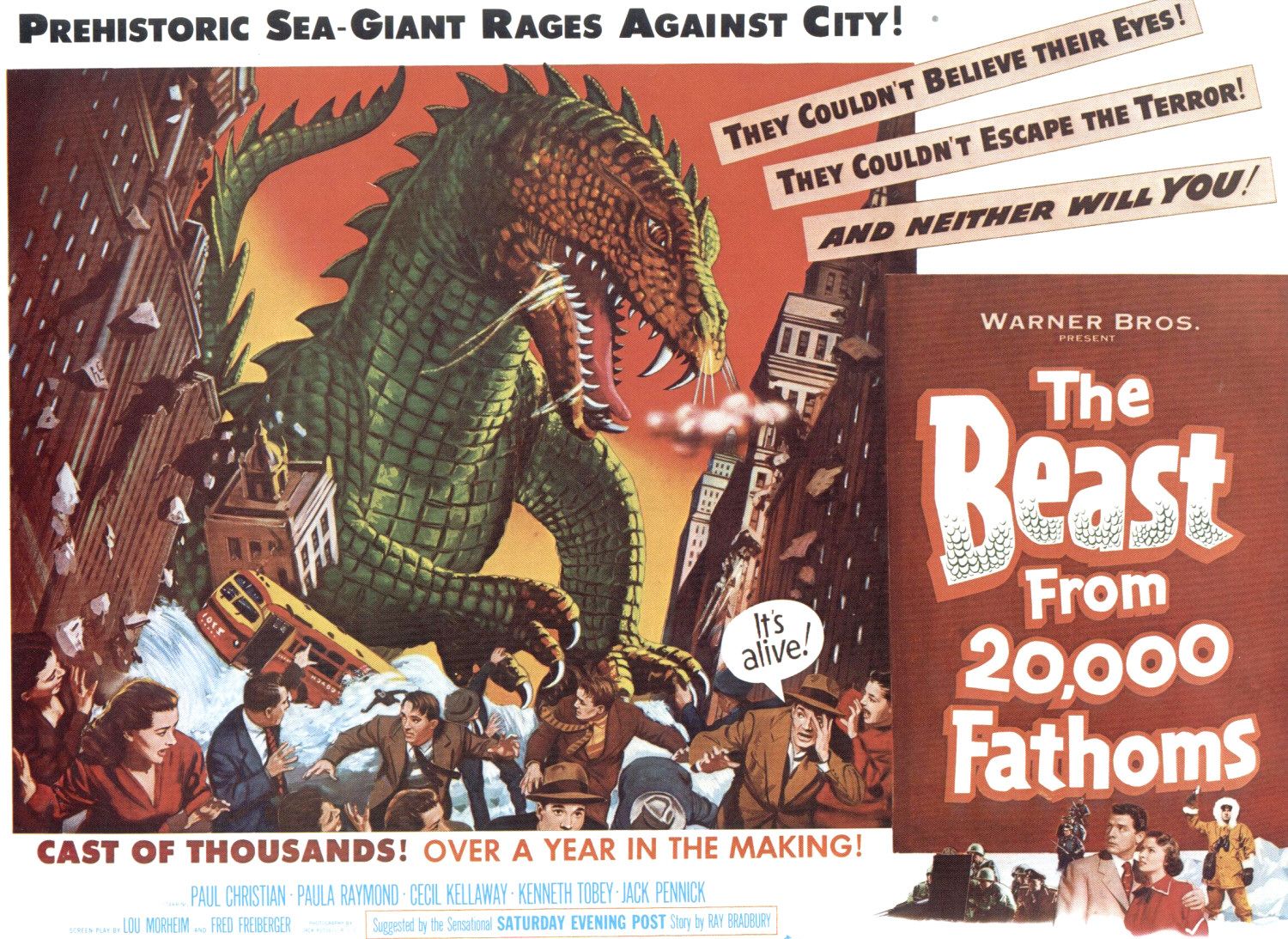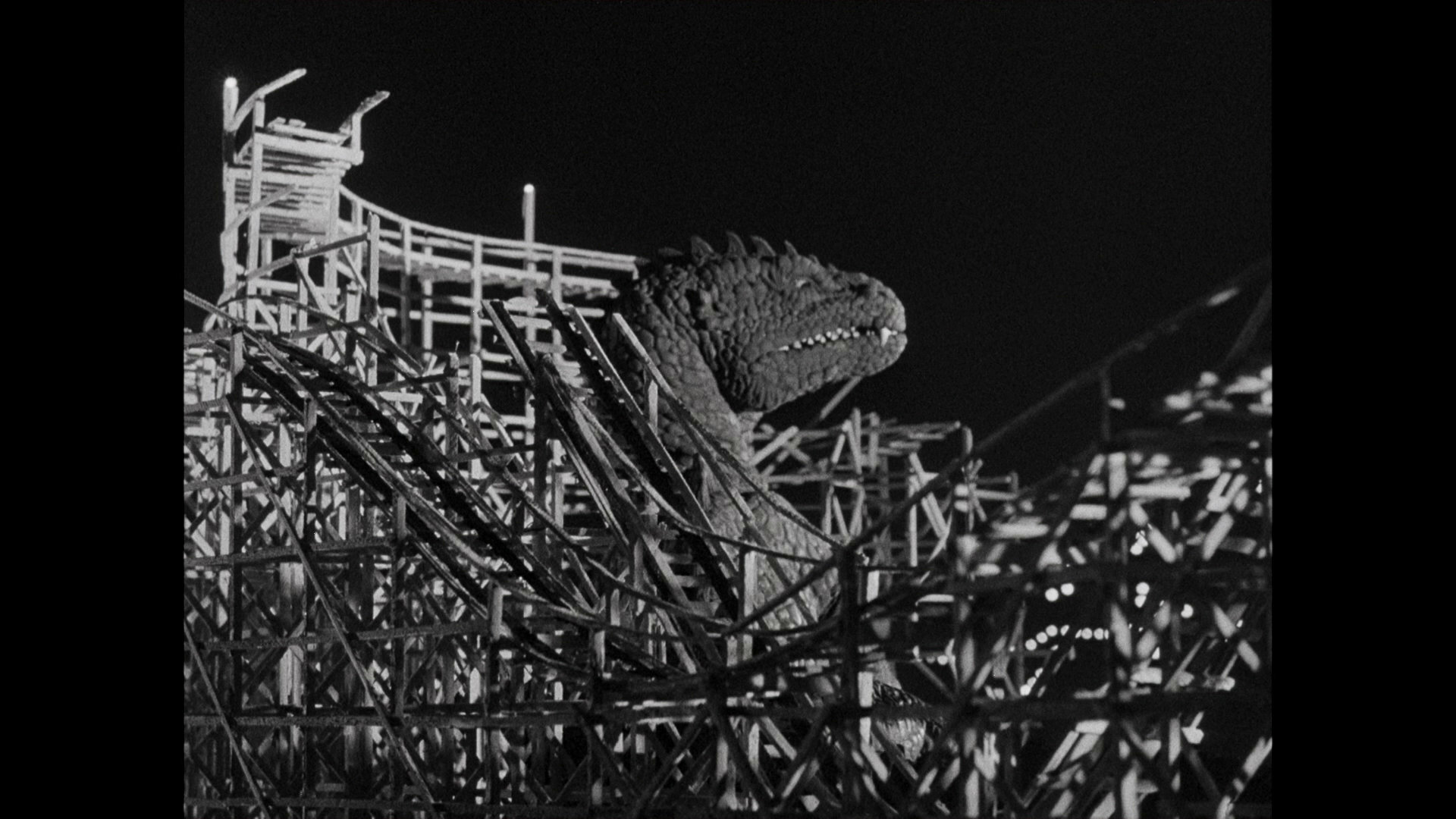 |
| Fig 1. |
Produced by Warner Brothers in the decade that gave us “The Blob” (1958). “The Beast From 20,000 Fathoms” (1953) dir. Eugène Lourié, concerns the growing mystery around the ancient Rhedosaurus, a beast that is suddenly released from its frozen sleep by an atomic bomb test in the arctic circle and journeys south to its original spawning grounds, where New York City now stands in its way. In terms of consideration of its qualities as a “B-Movie”, this is most definitely a part of that definition; “The Beast From 20,000 Fathoms” is an action driven science fiction film that features giant dinosaurs, stock characters and tropes, so - what could be argued to form the bread and butter of “B”.
Top billed performances include Paul Hubschmid, Paula Raymond, Cecil Kellaway and Lee Van Cleef, and for the most part their work is commendable, and in terms of believability it’s actually quite surprisingly sold well, though, with the exception of Van Cleef (who at the time wasn’t a household name - with only a few roles to his name) the other actors are all relatively small time, or jobbing actors like Kellaway, who had racked up 148 acting credits in his lifetime, so it’s possibly fair to posit him as a sort of “jobbing” actor. None of them particularly stand out as such, but that also means that none of them are particularly bad - except whenever a character shoots a gun, as, when it occurs - and it does frequently towards the end of the movie - it is incredibly unconvincing.
With monster effects supplied by Ray Harryhausen, and serving as a partial inspiration for some elements that would appear in the 1954 film “Gojira” - arguably one of the most well known amongst the monster movie, and later the “Kaiju” sub-genre - Writing for FernbyFilms.com, Rodney Twelftree says “As a modern viewer of The Beast From 20,000 Fathoms, the film ticks every single box in the template its descendents have followed ever since. The disbelieving science and military community, the gradual revelation that something is coming into contact with humanity, the precise and convoluted manner in which the creature needs to be destroyed, and of course the square-jawed hero and his female assistant” (Twelftree, 2016). To comment on this films use of tropes is a little difficult, especially when keeping the thought of it being a precursor to a certain sub-genre. Indeed, all of the elements at play here are now considered tropes, the use of Atomic power to explain the emergence of the beast (as later seen in Gojira) the idea that the beast must be studied for science, the forensic gaze given to the beast’s level of destruction and the uncertain nature (or “Adaptive Villainy”) of the Beast is something of a throwback to earlier features like “King Kong” (1933).
 |
| Fig 2. |
In terms of quality, the tone is well and truly set here when the Narrator introduces us to the occurrence that kicks the entire movie off, codenamed “Operation Experiment”, but it is certainly diminutive to its overall charms to say that this level of goofiness/playfulness is present throughout. The elements that define “The Beast From 20,000 Fathoms” as a “B-Movie” are the general areas where corners have been cut. There’s a flimsiness around some of the visual elements at play here, towards the beginning of the film we're treated to a Chuckle Brother-esque doll effect, wherein a character falls down a hole and lands with a solid yet unconvincing thud, and with regards to the use of stock footage that seems as though it’s there just to pad out the run-time. For instance, there’s a fight between a shark and an octopus that is incongruous to the overall narrative at play. In fact, it’s never really addressed at all before or after, but importance has been placed on this moment by giving it focus. Within this very segment footage is looped back on itself, shots are repeated and in general, it’s very ropey. In addition to this, there are some very obvious uses of miniatures; again, in the underwater sequence preceding the shark/octopus fight, the diving bell and its surroundings are starkly at odds with the overall quality of the picture. There are also elements of the dialogue that ramp up the cheesiness here, with particular devotion to the explanation of atomic power at the start of the film, in order to sell the conceit that the beast itself is poisonous - much later on.
There is, however, the obvious spectacle, driven by Harryhausen’s work on the Rhedosaurus, which is as strong here as in his later work on “Jason and the Argonauts” (1963). It is the definite highlight of the piece as he employs his strength at applying pathos to these large creatures. Interestingly, this creates a gulf between the quality of these effects, and ones employed within live action footage, but for the most part the two camps play nice and mesh well together.
The pacing is well trodden and plotted as the monster is effectively saved for key moments of the film; showing a less bombastic use of the movie monster, and ultimately saving this film from mediocrity. It’s this sensitivity that elevates the material and cements “The Beast From 20,000 Fathoms” as a good example of the genre as a whole. It might feel very “old hat” to a modern viewer but this is simply because you’ve seen variations of this in every subsequent giant monster movie since. Take “Cloverfield” (2008) for instance, in the most basic description the monster comes from the sea and attacks New York. It’s motives are just as obscure as the beast in 20,000 Fathoms, and just as in “The Beast From 20,000 Fathoms”, the monster is destroyed by nuclear power.
 |
| Fig 3. |
You can of course see similarities between “The Beast From 20,000 Fathoms” and “Gojira” as they’re practically the same film, with a key difference in the importance of the political message included in Gojira. It goes further than this though, as Tom Roberts, writing for StarburstMagazine.com suggests “The use of New York as an iconic location was pioneered by King Kong (1933). Indeed, with all features on monster films, it’s impossible not to trace an awful lot back to Kong. With The Beast, however, there are certain shots which have then been echoed - the Rhedosaurus climbing out of the river, and walking the streets in broad daylight are all almost shot-for-shot used in 1998’s Godzilla.” (Roberts, 2012) “Cloverfield” is perhaps the most direct comparison there is though, as the movie signposts this with the constant reference to Coney Island (where the finale of 20,000 Fathoms takes place) and even going so far as to include a frame of the beast around the midpoint of the movie when another Coney Island reference is made.
Needless to say, it’s incredibly easy to spot the influence of “The Beast From 20,000 Fathoms” on the genre as a whole. It is most certainly a “B-Movie”, but definitively of the “B-Movie” elite, an example of film that has long reaching influence on the way monster movies have been produced since its release. Characteristically ropey in a few places, pantomime-esque in others, it presents an odd charm that is easy to overlook for the cynical eye.
Bibliography
Roberts, Tom "The Legend of Harryhausen's Beast" [online] http://www.starburstmagazine.com/features/feature-articles/2206-the-legend-of-harryhausens-beast [Accessed 06/11/2016]
Twelftree, Rodney "Movie Review – Beast From 20,000 Fathoms, The" [online] http://www.fernbyfilms.com/2016/08/08/movie-review-beast-from-20000-fathoms-the/ [Accessed 06/11/2016]
Illustrations
Fig 1. The Beast From 20,000 Fathoms Poster. [image] Available at: http://www.impawards.com/1953/posters/beast_from_twenty_thousand_fathoms_xlg.jpg [Accessed 06/11/2016]
Fig 2. The Beast and the Lighthouse. [image] Available at: https://blogger.googleusercontent.com/img/b/R29vZ2xl/AVvXsEj1XdX_Rvepv2b-CNdk90QvHOI1WBxL5N4Z3TmN0RVpbts_Kj_vUeCANXlFEaqfcDnIs-DS2FpmOwLFzhjZgeo5qN32ZG-o7t-Pk907ZiSB2_gI5562cTsk-Kcy1VH-Do3kvriKImLF1MK-/s1600/The+Beast+from+20,000+Fathoms+light+house.jpg [Accessed 06/11/2016]
Fig 3. The Beast on Coney Island. [image] Available at: http://cdn.highdefdigest.com/uploads/2015/10/28/High-Def_Digest_Blu-ray_Beast_From_20000_Fathoms_Special_Features_Collection_4.jpg [Accessed 06/11/2016]

No comments:
Post a Comment